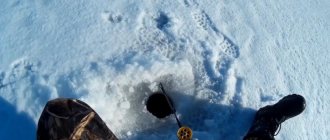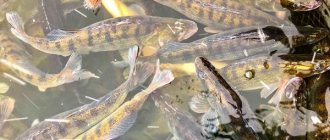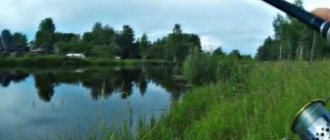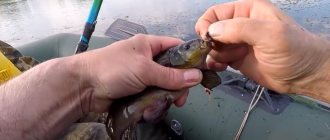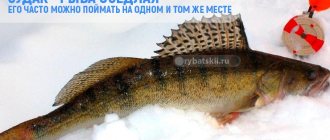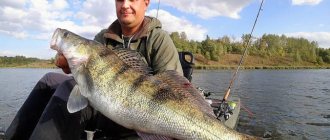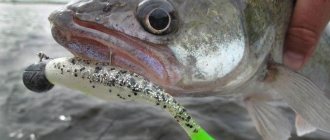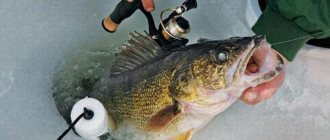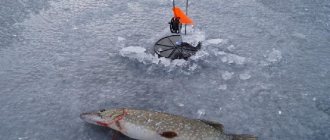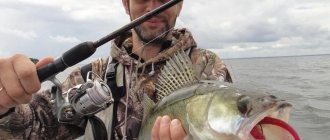Jigs for pike perch for winter fishing - baits, equipment, fishing techniques
The use of jigs for pike perch for winter fishing shows itself in the dead of winter, when the predator refuses to take artificial bait without a fry or worm attachment. The use of such equipment in winter is advisable at great depths and strong currents of rivers, where fishing by other methods is problematic. In such conditions, a stepwise descent of the jig with the fry under the ice along the current and back works better. Many anglers catch winter pike perch using jigs. In this article, jigs for pike perch are considered not as a separate type of bait, but as a fishing method. Therefore, the equipment can use heavy jig heads, cones, and knockers instead of jigs. And this is understandable - the size and weight of pike perch jigs are very close to jig heads
Features of equipment for fishing with live bait
- To fish for whitebait, it is enough to use any trolling rod equipped with a 10 cm nod and a line with a cross section of 0.14-0.16 mm. There are many colorful jigs for whitebait fishing, but their main purpose is to deliver bait to the fishing spot. Therefore, you can choose an inconspicuous lead “drop” with a strong but thin hook No. 6 to avoid the fry from leaving.
- In each individual case, it is necessary to select a variant of playing with a jig, but the retrieve should not be fast, and frequent pauses must be made. It is better to do them on the bottom or above the bottom, since this is where the perch takes the bait well.
- Sometimes for a good bite, swinging the jig with the fry just above the bottom is enough. In the process of fishing, you often have to select the frequency and amplitude of oscillations. Despite constant experimentation, there is always the most successful version of the game.
- By lifting the jig from the bottom, you can always determine by the movements of the nod how active the fry is and whether it needs to be replaced with a fresh one.
Winter fishing for pike perch with a jig
Before reviewing the gear and fishing techniques itself, let’s consider the general features of pike-perch fishing in winter. The main point of catching pike perch with a jig is searching for a predator. This moment is decisive in fishing for the prickly robber. Features of winter behavior of pike perch and search locations are described in detail in this article:
If the stopover and exit points for pike perch are known in advance, then stationary fishing tactics are used, carefully fishing the promising area. If there is sufficient current strength, it is advisable to place several tackles with a hanging hook above the jig on a long leash. The nozzle will play in the current. And while waiting for bites on the stands, they actively fish nearby, playing. On an unfamiliar body of water, you need to apply all your knowledge and experience in winter search for pike perch. Sometimes you have to travel many kilometers before the fanged site is found.
In addition to standard fishing with jigs and bait, some fishermen practice reelless fishing for pike perch using devils. The devil is a type of jig, but the equipment and fishing technique are very different from ordinary jig fishing for fry. This is a topic for a separate article. Catching pike perch with jigs in winter without bait is more promising at the beginning and end of winter. This is probably the lot of special connoisseurs, since at such times it is easier to catch striped fish with standard spoons or balancers.
Catching pike perch using a jig with baited fry
For more than forty years I have been catching pike perch using a jig with a whitebait, but I still cannot find a definite answer to the question about using a suspension. Fishermen do not have a consensus on this matter either. Only about a fifth of them are supporters of fishing without suspension. Others prefer the option with suspension. So which is better?
Without a pendant, it's like having no hands
“If you don’t know what to do, act according to the rules,” as the popular wisdom goes. But there are no rules in fishing. There is some expediency. For example, by using a harness, we double the number of baits on the rig and, apparently, increase the number of bites. Although opponents of the suspension claim that if a pike perch in a suitable mood sees a bait with a fry, then it will definitely grab it.
The absence of a suspension will supposedly even speed up the attack, since (as a pike perch does not need to waste time choosing from two objects in its field of vision. The latter, of course, belongs to the realm of speculation in defense of its position. In addition, in the suspended version, the baits are on different in height: one is at the very bottom, the other is raised. Therefore, I am still ready to agree with the opinion of the majority and most often when equipping a pike-perch fishing rod I use a suspension, although every time I go fishing I clearly see certain shortcomings of such equipment.
Threat of losing a trophy due to suspension
The first drawback I would probably name is the fact that when a large pike perch bites on a heavy lower jig, we will most likely lose it at the moment when the pendant, equipped with a rather large hook, gets caught on the lower edge of the hole. A pause in fishing, when it is not possible to hold the prey tightly on the line, most often allows it to free itself. Sometimes the line breaks and the bait is lost. I am writing about this under the impression of a recent trip to the Don with my son, then we each experienced two such offensive gatherings, losing the largest prey. To be fair, it should be said that such a situation is not hopeless. If the line is strong enough, when biting you need to hook sharply and powerfully. A very sharp jig hook will pierce the pike perch’s jaw, and the trophy is yours. You can also play it safe by slightly slowing down the pulling out of the fishing line when the pike perch approaches the ice, and try to insert the pendant into the hole without getting caught on its lower edge.
Read: The three most popular jigs – expert opinion
In the old days, when I made plexiglass pendants myself, I tried to combat the described trouble by installing smaller hooks. It helped. True, I used not a fry as a bait, but several pieces of large bloodworms.
On the “brush” of bloodworms there were bites not only from bersh, pike perch, but sometimes from bream. Although, of course, you can’t catch a trophy pike perch on a small hook. And for bream you need a large hole. We tried to drill holes inclined towards the current. But this is labor-intensive and ineffective.
Fighting entanglement
The second disadvantage of the suspension is that its leash, when lowering the baits to a depth and when rising to the hole, twists around the main sand and gets tangled. Unraveling is necessary because otherwise the pendant will not work effectively. Usually, when moving to a new hole, we do not twist the line onto the fishing rod drum, but select it onto the “yoke” from our hands. It is impossible to adjust the pendant and untangle the leash, since your hands are busy. You have to lay out the fishing line on the ice, risking tangling it, especially when the wind is blowing, and crumbs from holes drilled in it are scattered on the ice.
How to reduce pendant tangling? Firstly, it is worth shortening the suspension lead to 10-12 cm. Secondly, install a splitter, from which the branch lead will go to the suspension, and the main one will go to the lower heavy jig weighing 10-20 g, depending on the intensity of the current and depth. The length of the leash of the lower jig should be about 25 cm. The splitter should be miniature so that it does not scare away the fish attacking the pendant with the fry. Finally, you can eliminate the harness leash altogether and install it directly on the main line, using the hole or “eye” in the harness. In the latter option, we will eliminate entanglement by eliminating the leash, and significantly reduce the risk of suspension delay when passing the lower edge of the hole. However, a leashless harness will not play under the influence of the current and, as experience shows, bites on it will occur much less frequently. The choice, as they say, is yours.
Read: Fishing in winter on river backwaters
The third disadvantage of gear with suspension is its higher tendency to bottom hooks compared to the non-suspension version. In this case, no release will help. You will lose everything: two baits, a splitter, and two fry. It’s good if you have a spare ready-made fishing rod. Otherwise, the unpleasant procedure of tying the equipment in the cold with bare fingers is inevitable. You suffer and waste precious time, while those around you admire the bites, excitedly hook and fish for prey. How to get rid of the troubles associated with using a suspension?
Fishing rod for pike perch on the Volgograd Reservoir
I will note some of the preferred, in my opinion, features of a pike perch fishing rod designed for depths of up to 30 m. I mean, first of all. Volgograd reservoir. Let me start with the fact that it is advisable to have the winding diameter of the reel drum at least within 50-60 mm, no less. Of course, almost no one uses a reel when fishing for prey. It is much better to control the resistance of the fish by choosing the line with your fingers. But when moving from hole to hole, you can at least partially wind the line onto the reel, reducing the likelihood of the line getting tangled on the “yoke” near your hands. The reel should have a “central” rather than lateral location in the fishing rod. This will allow you to place the fishing rod 8 in a fishing box more compactly. The reel handle and itself should rotate freely on the axis without jamming.
A little about the equipment of a pike perch fishing rod. The leash going to the lower heavy jig should end with a small swivel with a carabiner. This will allow you to select and install a jig of the required weight on site. For example, having arrived on the Don and started fishing, you see that the current is weak and almost does not carry the bait when you play with it at the bottom. It makes sense to replace the lower jig with a lighter one, so that when fishing a given hole, the bait will be carried away by the current by 3-5 m, thereby significantly increasing the area of the bottom examined in search of fish. Accordingly, fewer holes will need to be drilled, and the number of bites will increase. The presence of a carabiner will make it easy to select the weight of the lower jig, provided that it has a loop and not a hole for tying the fishing line on the hook.
Read: How to make your own jig
There is one more nuance that is worth focusing on. Some anglers use frozen fry from the refrigerator. They say that pike perch don’t care whether it’s a live fry or an ice cream one. I don't agree with this. Although, by transmitting the action of the fishing rod through the nod and fishing line to the bait, we seem to be reviving a dead fry. But, of course, live fry are more aromatic, tastier and more attractive. And if the hook of a jig or pendant is carefully passed through the mouth under the gill of the fry, and then, without damaging the ridge, a puncture is made under the fin, then the fry will remain alive for a long time. I will also add that I often hook the fry by making a puncture under the fin. Then, positioned across the current, it behaves more actively. The bites become more frequent, although the pike perch “knocks down” such fry with impunity more often than in the usual version. But there is a point.
Now about the nod
When fishing with a spoon, you can, having a thin six and a “tulip”, do without a nod. But when fishing with fry and suspension, a nod is necessary, especially when controlling bites on the suspension, since it is not rigidly connected to the main line, tensioned by the lower jig. If the nod is based on a steel spring, never pass the fishing line inside it, since when the fishing line freezes, ice will pack into the spring and damage the fishing line. Follow the rule: all holes through which the fishing line passes must be at least 5 mm in diameter.
When choosing pendants, pay attention to the fact that the hook is strong and the fry can be comfortably placed on it.
Mormyshka
Tackle
The rigging of a fishing rod for catching pike perch in winter with a jig depends on the size of the object being hunted. For large pike perch, the tackle is adjusted accordingly:
- Reliable elastic fishing rod with reel.
- The nod is selected depending on the weight of the bait and the strength of the current. It should not be completely bent by the flow of water and clearly register a bite on the rise by extension. Typically metal or spring guards are used.
- Fishing line about 3 mm (winter fluorocarbon with low elongation).
- Large jigs weighing up to 30 grams with powerful, sharp and large hooks.
When fishing on a stand, you can use not a fishing rod, but any structure with a device for winding fishing line and a guard - there are no requirements for mobility. What is more important here is the possibility of stable fastening in a working position on the ice. For medium (small) pike perch and perch, you can use tackle of the same caliber as for perch. There will be more bites, it’s convenient to work with. But when catching a trophy specimen, you can be left without a trophy and bait.
The equipment itself is completely different. The simplest option is one jig at the end of the fishing line. But a more catchy option is to place another hook or light jig higher in the forest on a branch leash. This hook is also baited with bait. Often, especially in the dead of winter, when the predator prefers small baits, bites occur only on this provocateur. You can experiment with rig options, for example, placing a fly or rubber bait on top. But it is still recommended, especially in the middle of winter, to use animal bait.
What to use to catch pike perch in winter?
Spoons
The most common gear for vertical fishing for pike perch from ice is winter spinners. It should be elongated, narrow in shape, since pike perch has the same narrow mouth. Medium size, 5-10 centimeters long, preferably with a metallic tint. Bimetallic ones are especially effective. The weight of the spoon is determined by the conditions of a particular reservoir and the speed of the water flow in the fishing area. It can reach 30 grams for fast rivers, but 10 grams is enough in standing water. The following types of spinners are recognized:
- Gliding spinners . The most common type. The flattened, streamlined shape of the “glider” is designed to create floating effects along with a game that captivates predators. May differ in size, position and number of hooks, color, etc. Effective at depths up to 4-5 meters.
- Spoons with a shifted center of gravity . Subtype of gliding spinners. Due to their peculiarity, they are able to imitate the throws of frightened or sick small fish.
- Tri- and tetrahedrons . People call them “St. Petersburg”. This is a flat, elongated spoon with a faceted cross-sectional shape. Usually made with crowns made of two different metals, equipped with tees.
- Scandinavian women . Scandinavian spinners have proven themselves well in the dead of winter. Versatile and effective. A distinctive feature is the chain-tail with a hook at the end. May vary in shape and play.
- Castmasters . One of the best spinners not only for pike perch, but in general. It has a number of features. Valued for its original game, it can provoke even an inactive predator.
- Williams . Modern spinners, made in Canada. It has a good glider and attractive gameplay. Additives can ruin this.
Beware of fakes. Try to buy only branded gear. They have the balancing necessary for proper play and are made of high-quality materials.
Spinner Scandinavian
Classic Castmaster and Halco Castmaster Spinner Williams
The trolling technique is standard: smoothly swing the fishing rod up and release it back. Take short breaks at extreme points. It is necessary to periodically change the holes.
Balancers
Used from 5 to 10 centimeters in length. The weight depends on the speed of water flow in the reservoir, varies from 10 to 30 grams. Choose “phlegmatic” balancers with narrow stabilizers. The pike perch takes these with pleasure. Play it measuredly, smoothly, with pauses. Sharp, dominant movements of the bait can scare off a predator. Lower the bait to the bottom, then swing the rod 20-30 centimeters, stop. Descent to the bottom and a long pause, 20-30 seconds. And the game starts again. It is important not to rush, to show patience and endurance. Starve out the pike perch.
Pike perch on the balancer. Principle of operation
Balancers for zander
Pike perch caught on a balance beam
Amphipods
A bait similar to a balance beam. It is distinguished by a flattened shape and a displaced center of gravity. Due to this, it hangs in an inclined position. In the center, on the side, there is a hole: a fishing line is threaded into it, to which the tee is attached. A tail with another tee and a tassel of wool. Pike perch quickly responds to the active play of amphipods. She looks like a louse fry. The main thing in this case is to find a place where the pike perch will notice the bait.
Replanting
Options for baiting tees
To make the bait more attractive, you can equip the hooks with bait: a few beads or fish giblets, a regular red woolen thread, a piece of fabric and even colored foam will do. In short, something that will make your bait more attractive to pike perch. This way you will be more confident in attacking. Remember that baiting can ruin the performance of the spinner.
Mormyshka
Massive jigs - large-sized pike perch jigs are used at depths of 5-15 meters, in reservoirs with fast flowing water. A fry or bait from a piece of fish is put on the hook. Remember that when fishing for walleye, you must move frequently to follow the fish. They play with a jig at the bottom for up to 5 minutes - this is called active fishing. They play smoothly and slowly.
Mormyshka and live bait options
You should cut sharply, at the moment when you feel a blow or tension.
On the ball
“Balda” is a sinker with a pair of hooks. Beads are attached to the hooks, and the bait itself is tied to the fishing line. Then they lower it to the bottom and begin to “knock the cannon” on the surface. Avoid sudden movements while playing. Usually, the jumping "buldha" resembles a swimming beetle, but they are also made to resemble crustaceans. The main condition is the symmetry of the product.
Purchasing pike perch
Homemade version of the bulldozer for pike perch
Another homemade version of the bulldozer
Video on how to make a do-it-yourself bulldozer at home:
To the zherlitsa
It will take a lot of fishing line! Before swallowing the victim, the pike perch can swim tens of meters with it. Be prepared for this. The reel must have a lock. For camouflage purposes, a single hook is used, this reduces the risk of scaring off a suspicious predator. When fishing in the current, use a retractable leash. Live bait is taken in small sizes, weighing up to 30 grams. It is necessary to check the live bait, it must remain alive.
Pike perch caught with a zherlitsa and live bait
Underwater gear layout
Appearance of the girder
Zhivtsovka
Fishing with live bait is carried out using the girder method. The following will pass for live bait: redfish, bleak, roach, brush, gudgeon and other small fish with a low body.
Lures
Jigs for pike perch are large and heavy, usually from 7 to 35 grams. At greater depths and currents, ordinary summer jig heads are used. The most commonly used baits are drop-shaped baits and cones. A distinctive feature of pike perch jigs is their horizontal suspension (fully or at an angle). It is in this position that the nozzle is placed correctly. If possible, it is better, instead of jig heads with straight hooks, to use special winter jigs for pike perch, in which, due to the bend, the hook is located at a sharper angle to the vertical of the suspension - the tail of the fry, when such a bait is on the bottom, looks up, as if a fish buried her head in the bottom and was looking for something there. The most catchy jigs for pike perch for winter fishing have exactly this shape. Often fishermen make jigs for pike perch with their own hands.
In principle, in conditions of poor visibility, the shape and color of the bait almost does not matter. The vibrations that the pike perch detects with the lateral line are also produced by the ball of the jig head. But at the final stage of the hunt, the pike perch most likely uses its vision, making a dash to the point of attack. The bait (whole or chopped fish) is also important - the striped robber has a well-developed sense of smell. Therefore, the shades of colors are unlikely to change anything. Often fishermen do not paint jigs at all, using ordinary lead jigs. However, phosphorus jigs for pike perch in some places work better than usual - which means that the fanged predator still navigates in the dark and with the help of vision. A common rigging option is to paint the body of a heavy bait with phosphorus varnish and use a light plastic light-accumulating jig on the top suspension.
Fishing tactics
We have already partially touched on the process of fishing with pike perch jigs in winter. Tactical options may be as follows:
- An active hike with one fishing rod in an unfamiliar body of water. A few minutes on the hole without a bite - we move on. There are bites - we fish around more carefully.
- Displaying several fishing rods in a standing position is a passive method. It works in the current if the place where the pike perch stops (outs) is known exactly.
- Targeted search for trophy specimens (usually they stand separately in the most remote places). Searching for places - using an echo sounder or personal knowledge of the bottom relief of the reservoir.
Tactics for catching pike perch in winter using sprat
The tactics for catching pike perch in winter using sprat can be different:
— One method : Several people fish a large area at once, starting to intensively drill holes; — Another method : One angler tries to choose two or three places where he fishes for the rest of the time.
Each tactic has its pros and cons. For example, if you actively start looking for pike perch, the likelihood of catching it increases sharply. On the other hand, the pike perch may simply hide and not respond to the bait.
In winter, the fish are inactive, so in some cases the pike perch needs to be “stirred up.” Fishermen tell how pike perch sometimes began to bite where there had been complete silence for several hours. And how can you stir him up and make him start pecking?
— Many fishermen, slowly moving forward, begin to drill holes across the dump, thereby “groping” for the pike perch trail. In general, you can use different methods, both. Of course, on an unfamiliar body of water, you will still have to drill as many holes as possible at first, so you will at least have some catch. And study the bottom topography thoroughly, it will be useful to you in the future.
Catching pike perch in winter on a reservoir (Educational film)
Playing technique
A jig for pike perch is, first of all, just a weighting agent for the bait. The main thing is the bait itself. Therefore, there is no game as such (as in Rewindless). The fisherman makes various twitching, tapping, swaying movements, alternating them with long pauses. During pauses, bites occur more often. The pike perch can take it sharply, hang heavily, or gently - on the rise of the nod. You should strike sharply, and in case of a large working descent at depth and strong currents - sweepingly, sometimes with standing up or taking a step back.
Usually the jig sinks to the bottom, and the slack in the fishing line is taken out. Then the tackle rises 10 centimeters and falls again. After a pause, the lifts are repeated. The height and frequency of rises, the dynamics of the movements of the bait are determined experimentally. But the general trend is that the game needs to be sluggish, slow, even and long-lasting. When lowering into the hole, if there is no bite in the first couple of minutes, make several sweeping oscillations. Perhaps this will attract a predator from a distance. But on the other hand, such a technique can scare away the pike perch, which has already approached the bait and is watching it. Additional techniques - tapping on the bottom, intermittent slow twitching, trembling. The main thing is to do everything smoothly, not abruptly, with long (up to 20 seconds) pauses.
When the current is strong enough, you should definitely try to tap on the bottom so that the tackle is gradually pulled under the ice. To do this, sometimes you need to select the correct weight of the jig or jig head. But it’s worth it - pike perch responds well to such rafting. In addition, the fishing area per hole increases significantly. In common parlance, this method of fishing is known as rolling.
Nozzles
When using jigs to catch pike-perch, the bait usually uses whitebait caught from the same reservoir. The closer to the wilderness, the smaller the fish needed. In mid-winter, the best option is fish 3-4 centimeters long. They are inserted completely through the eye and then again into the middle of the body. Sometimes slices, strips of fresh fish, or tails work well. A worm sandwich is often used. The fry can be caught in the same reservoir using a lift; in places with developed fishing infrastructure it is sold separately. This is the best variant. Sprat, smelt, verkhovka, pipe cleaners, minnows - everything is suitable. Catching pike perch in winter with sprat and jig on the Volga, Kama and Oka is a separate topic for discussion.
In the absence of whitebait, store-bought frozen sprat, sprat or capelin will do, as well as sliced fresh fish from home from a previous catch. Belly strips of the same pike perch from a previous fishing trip will do.
Habitats of pike perch. Where to look for pike perch?
Successful fishing for pike perch in winter using sprat directly depends on the chosen location. Experienced fishermen have their own specific places, which they mark on the map in the summer. Some use GPS, others simply sketch on paper, and others, more experienced ones, simply memorize visually. Pike perch, for the most part, like to be in clean water, where there is very little silt. At the same time, for its stops or movement along a reservoir, it chooses the bottom topography: with holes, rifts, and places of depth changes. Often pike perch is caught under snags or near flooded trees.
Pike perch is also active at night . Usually it rises to the upper layers of water to hunt for fry. That is why it is so successfully caught on the surface at night. To help the angler quickly find pike perch, you will need an echo sounder. It is with its help that depth differences, edges and holes are found as quickly as possible. If the height of the step at the bottom is about 1 meter, this means that there is a possibility of finding pike perch in this place. If the reservoir is unfamiliar to you, then it is better to start by asking local residents about the peculiarities of the flow and relief. Pike perch loves places with fast currents, as well as areas where the direction and speed of the current changes.
Jig for catching pike perch: in winter and summer
The jig for catching pike perch was born thanks to perch hunting. True, its size has been significantly increased in order to hook large specimens, so now it looks more like a jig head weighing up to thirty grams. This is due to the fact that fishing often has to be carried out at very great depths with strong currents.
But even during the deep winter, when the fish becomes lethargic and there is a period of complete lack of biting, this bait is capable of provoking a fanged predator to attack. In addition, pike perch often gathers in small schools, and if you can determine its location, you can get a good catch.
When to use pike perch on a jig in winter
Pike perch is quite widespread in our water bodies and is considered a commercial fish. This is the largest predator of the perch family. When fishing, it is able to provide decent resistance to the fisherman, so the gear is initially prepared to catch the fanged one.
- The rod chosen is very rigid and elastic, up to one meter long.
- There are no special requirements for the reel, as long as it is light enough.
- To increase sensitivity, a thin-section line would be ideal, but since there is always the possibility of catching a large predator, it is better to wind a decent supply of 0.18-0.25 mm monofilament onto the spool. If the choice fell on wicker, then it should be polymer-coated for winter.
- The nod helps in the correct play of the bait. The homemade product is made from a spring or a metal plate.
Such requirements for the rod are due to the strong mouth of the fanged fish, which has to be pierced with a sweeping hook. If the depth does not exceed seven meters, scaffolding with a cross-section of 0.18 mm would be appropriate; at greater depths, thicker monofilament is installed. However, you should not exceed 0.25 mm, as the performance of the bait will deteriorate sharply.
On large bodies of water, fanged fish are hunted throughout the year. With the arrival of cold weather, his behavior changes somewhat, but over time he returns to his usual course. On the first ice, fishing is carried out in shallow water, where various small creatures still live. Here he will hunt from two weeks to a month. Bites are observed throughout the day.
With the arrival of severe frosts, the activity of the predator begins to decrease, and it rushes in search of deep areas rich in oxygen. In small bodies of water it can become numb, completely stopping feeding. At this time, the bite occurs throughout the night.
As winter ends, fish activity begins to increase rapidly. The pike perch resumes its hunt, moving around the water area in search of fry. The bite is observed throughout the day. At this time, they try to catch snags, channel edges and slopes, riverbeds, holes and, in general, any changes in depth.
Do-it-yourself jigs for pike perch and factory products
Massive baits are considered the most optimal for catching fangs. In principle, there is a chance of catching a predator on smaller ones, but the size will leave much to be desired. The most widespread were Uralkas and features made to look like silver or gold, or even black.
As for the sizes, it’s better to take the largest size you can find; the Uralka will fit from number nine to number fourteen. It is important to pay attention to the hooks, which should not only be strong, but also be as sharp as possible.
They catch pike perch both with and without bait. And although baitless fishing methods sometimes bring good results, there are still many more supporters of using fish on a hook. By the way, they use not only natural bait, but also a silicone analogue.
It's no secret that using a jig makes it much easier to catch fish. However, to catch pike perch, it must be special, designed specifically for catching this predator. The bait is quite large, weighing up to thirty grams. Among the catchable ones we can note fang, cobra, bullet, larva and dolphin.
Among the wide variety, preference is given to large sizes of white color. Sometimes luminescent models are successful. In any case, we’ll tell you what you need to focus on.
The weight is selected based on the fishing depth and the speed of water movement. In a small current, a lead load is enough; if it is strong, it is better to tie tungsten, since its specific gravity is much greater.- The optimal size is considered to be 14 mm, although depending on fishing conditions, deviations in any direction are inevitable.
- Good results are shown by a bait made in the form of a large drop.
- The color can be any, but it has been noted that white, black, gold and silver models work most effectively.
Often, catchability is significantly increased, as motorists would say, due to different body kits. To do this, string a bead onto a hook, and then a piece of insulating wire. Such a combination can not only attract the attention of zanders, but also change the wiring.
But the jigs used by Saratov pike perch fishermen are more like a classic drop shot. Instead, a regular jig head is often used, which is mounted below instead of a sinker. In addition, instead of a hanging hook, you can tie a plastic luminous jig, used when fishing for bream. They do not fix it firmly, but press it between the bead and the locking knot.
The jigs used by Astrakhan fishermen for catching pike perch have a slightly different shape. More often they are homemade, with a cone-shaped geometry of various sizes, determined by the depth of the fishing and the strength of the current. They are made in most cases from lead without additional processing.
Homemade bait for pike perch
Winter jig fishing for pike perch - these concepts are so interconnected that some fishermen purposefully conduct ice fishing only for this predator, completely ignoring other types of fishing. It goes without saying that after trying factory baits, fishermen begin making them themselves.
In just a few minutes you can make a bait whose shape is somewhat similar to a spinner for vertical fanged fishing. To do this, you need a small piece of heavy wire and an elastic casing. It is pulled onto the wire and onto the shank of the hook with some force in order to fix the structure as rigidly as possible.
The product can be cast from lead no less successfully, as we wrote about in the article “How to choose the right jigs for roach.” With the help of plaster, it is possible to give a homemade product a wide variety of geometries. Also, if a fisherman has a very catchy bait, but in a single copy, it is not difficult to make the required number of copies.
To do this, the matchbox is filled halfway with gypsum diluted with water. The jig is coated with oil or Vaseline and pressed halfway into the solution, focusing on the hook. A wire is threaded into the hole intended for the scaffolding. To speed up the casting process, several jigs are placed in one mold.
Small channels through which molten metal will be poured are made of conical wooden elements. In order for the halves of the mold to always fit correctly, it is necessary to make arbitrary recesses, which will be filled with gypsum mixture when pouring the second half. Here they will already look like protrusions.
The hardened surface is coated with Vaseline or fat, then the matchbox is filled with gypsum mortar up to the very edges. After the mass has hardened well, the mold elements are undocked, the jigs are removed, and the excess is carefully ground. The homemade product is ready to work.
Summer fishing for pike perch using a jig, floating and from the shore
In open water, fanged fish are caught no less successfully than in winter, the main thing is to be able to determine its habitat. Fishing time is of no small importance; for example, morning fishing is best started at dawn and continued until ten o’clock. After a daytime break, the bites resume after five in the evening.
- The fanged fish prefers clean areas of the reservoir with a sandy or rocky bottom. Does not like silted areas and muddy water.
- They also look for fish on dumps and edges, in the immediate vicinity of holes, not far from the riverbed.
- A good meal comes after spawning, with the beginning of summer. True, if there is extreme heat in the reservoir, bites become rare and become more frequent only with the onset of cloudy weather.
- In the evening, pike perch and bersh go out to hunt fry; their location is determined by the young of the year splashing in different directions.
When fishing by swimming, the optimal rod is one and a half to two meters with a spinning reel. The jig is very large, the size of a cherry, equipped with a hook number 5-9. To increase sensitivity, you cannot do without a nod. It is not difficult to make it yourself from a piece of scaffolding with a cross section of 0.8 mm and a length of 20 cm.
This is done like this: a double knot is tied in the middle without tightening. The result should be an eight. It is straightened into a ring, the free ends are twisted and cauterized. Attach the guard to the tip of the fishing rod using electrical tape or thread so that it protrudes. The line is passed through the rings and then through the nod loop.
The bait can be any, based on the preferences of the fanged fish in a given body of water, but preference is given to small fish. For this purpose, fishermen even use frozen sprat purchased at the store. To attract a predator, threads of bright colors are wound around the bait.
How to catch a predator from a boat
The process of catching zander from a watercraft differs in that the jig not only taps the lower horizons of the reservoir, but also the rest lying above. This is why a rod that is too short will not be very comfortable. To increase the possible search areas, wiring is carried out not only in the horizontal plane, but also in the vertical.
Experienced fishermen claim that a jaded predator may be interested in combined wiring. Fishing technologies do not stand still, and it is easy to find models on sale that combine the best of a gliding vertical spinner and the classic nozzle jig - a feature whose characteristics we gave in the article “Summer jigs for bream and methods of tying them.”
At the end of summer, it is worth trying out vertical gliding baits with an elongated body and a blind or movable tee. With a small vertical amplitude and increased wiring frequency, they significantly outperform horizontal models.
Specifics of catching pike perch with a jig in winter
The jig is one of the most common fishing methods. However, to catch pike perch, you will have to equip it correctly. Due to the uniqueness of the fish, tackle must be selected based on the following features:
- jigs for pike perch in winter should be large in size, weighing up to 30 g;
- the rod should be selected to be rigid and durable and equipped with a nod;
- the tackle should be about 1 m long and at least 3 mm thick;
- the coil is taken inertialess;
- fishing line with a thickness of 0.2 mm.
Note! If the depth is large, then the thickness of the fishing line should be selected with a larger diameter.
Sometimes fishermen use a telescopic rod , which is durable, elastic and easy to use.
The tackle should be such as to penetrate the hard scales of the fish. When biting, you need to hook it hard so that the fish is hooked.
Worth knowing! In order to break through the mouth of a pike perch, the hook should be done with force and scope.
Winter pike perch does not like frisky play , so it should proceed smoothly and carefully, without unnecessary jerks. Playing slowly will hypnotize the fish and make them attack the bait. The game for catching pike perch with a jig in winter is played this way:
- First, you need to lower the bait to the bottom and pick up the slack in the fishing line;
- then raise the jig 5-10 cm from the bottom of the reservoir and sharply lower it back (pauses should be at least 10 seconds);
- gently raise the jig again, but this time by 30 cm;
- make gentle rocking motions while lifting.
This game should be repeated several times during fishing. If there is no bite in the selected area, you should change the fishing location.
Purchasing an echo sounder will be a guaranteed success for a fisherman, although the cost of this toy will cost the owner a pretty penny. With its help, you can not only determine the presence of fish, but also determine the topography of the reservoir.
One hole for fishing is not suitable, since it is better to fish with this gear at least ten places, the distance between which should be about 5 meters.
Important! The easiest way to catch fish is when there is first ice , as they are still actively splashing and moving around the reservoir. It’s also worth remembering that the ice is fragile at this time, and a friend’s help will come in handy, especially if the angler goes under the ice.
The middle of winter and severe frosts greatly affect the catch, so it is better to catch pike perch in the evening or at dawn, when the bite is activated.
Places for catching pike perch with jigs
Catching pike perch with a jig differs from other fishing methods. But first of all, you need to determine the location of the fish in the reservoir. Unfortunately, there are no exact recommendations on this issue. Success awaits only technically equipped fishermen (owners of an echo sounder) or fishermen who have studied the reservoir and its inhabitants in detail with their preferences. You still have to work hard. Just one drilled hole will definitely not get by, but, as you know, success awaits only the persistent. This predator has its favorite places: hills and holes located near river beds, edges, places with snags, and driftwood. In large bodies of water, attention should be paid to the bottom with uneven terrain. The hunter rarely goes into shallow water. The main condition for a reservoir: clean, transparent water without strong currents; in such conditions, fish can be caught well. Reservoirs, as a rule, are characterized by a high oxygen content in the water, which means that the fish in them will be more active. Attention! It is easiest to catch pike perch during the first ice, this is due to their increased activity and frequent movements around the reservoir. Never forget about safety; thin ice is often fragile. In the middle of winter, during periods of severe frosts, fish are less active during the day; there is a greater chance of catching them at night or at dawn. In such conditions, practically nothing but a jig will bring results. But if you can accurately determine where this fish is located, then excellent fishing is guaranteed. To quickly discover the location of fish in winter, it is more profitable to act in groups. Thus, with division it is possible to cover a much wider area.
